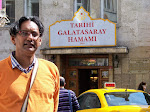In 1787 the company created its logo, still in use today, which is thought to be the world's oldest commercial logo that has been in continuous use since its inception.Under Associated British Foods since 1964, Stephen Twining now represents the company's ten generations. In 2006, Twinings celebrated its 300th anniversary, with a special tea, and associated tea caddies. Twining's is a Royal Warrant holder (appointed by HM The Queen).
In the U.K., Canada and the U.S., a tearoom is a small room or restaurant where beverages and light meals are served, often catering chiefly to women and having a sedate or subdued atmosphere.
A customer might expect to receive cream tea or Devonshire tea, often served from a china set, and a scone with jam and clotted cream – alternatively a High tea may be served. In Scotland teas are usually served with a variety of scones, pancakes, (Scottish) crumpets and other cakes.
 Tea at The Orchard, Grantchester, founded 1897There is a long tradition of tea rooms within London hotels, for example, Browns hotel which has been serving tea in its tea room for over 170 years.
Tea at The Orchard, Grantchester, founded 1897There is a long tradition of tea rooms within London hotels, for example, Browns hotel which has been serving tea in its tea room for over 170 years.The popularity of the tearoom rose as an alternative to the pub during the temperance movement in the 1830s. The form developed in the late 1800s, as Catherine Cranston opened the first of what became a chain of Miss Cranston's Tea Rooms in Glasgow, Scotland, and similar establishments became popular throughout Scotland. In the 1880s fine hotels in both the United States and England began to offer tea service in tea rooms and tea courts, and by 1910 they had begun to host afternoon tea dances as dance crazes swept both the U.S. and the UK. Tea rooms of all kinds were widespread in Britain by the 1950s, but in the following decades cafés became more fashionable, and tea rooms became less common.
n a related usage, a tearoom may be a room set aside in a workplace for workers to relax and (specifically) take refreshment during work-breaks. Traditionally a staff member serving food and beverages in such a tearoom would have been called a tea lady.






No comments:
Post a Comment